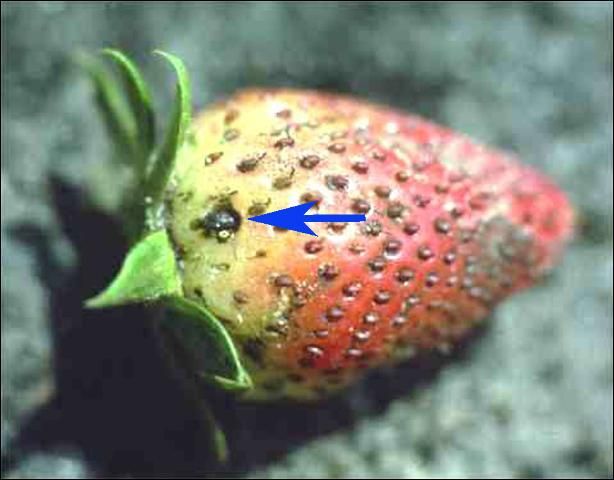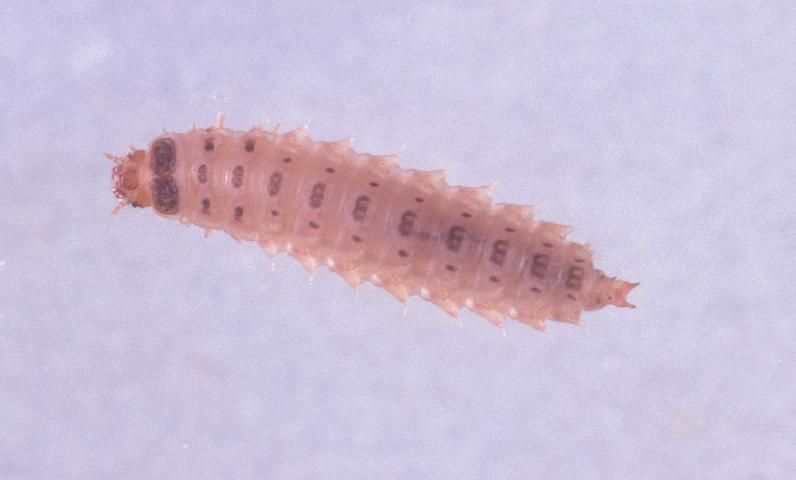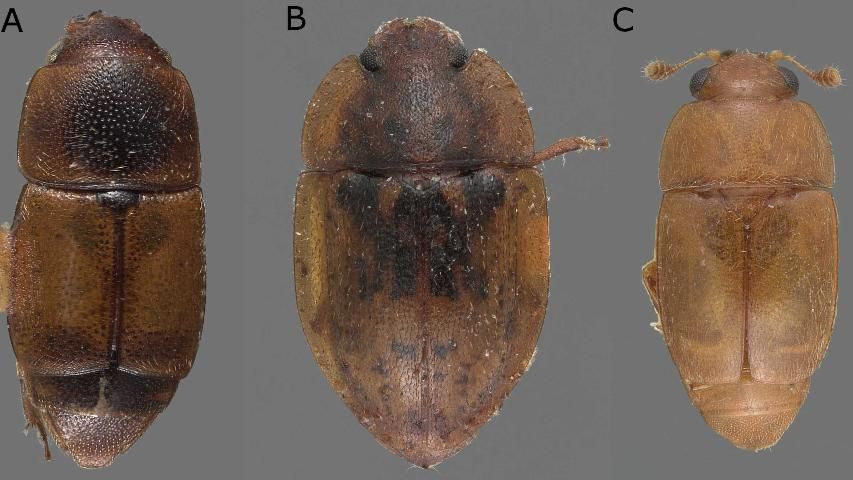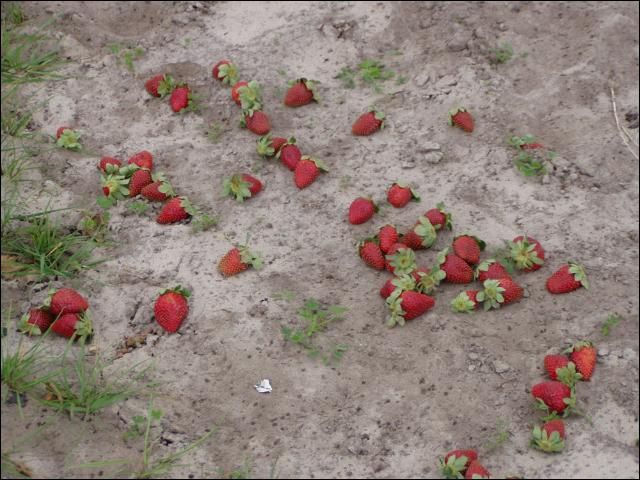Sap beetles (Coleoptera: Nitidulidae) are conspicuous insects that feed on flowers, fruits, sap, fungi, stored products, and decaying and fermenting plant tissues from diverse trees and crops, including strawberries. Sap beetles work in association with yeasts and other fungi causing the fermentation and decay of infested plant parts (Figure 1). They also transport a variety of microorganisms that cause plant diseases, and a few species behave as predators of various ornamental pests (Dowd and Weber 1991). Sap beetles are often considered minor pests; however, their main impact is due to the contamination of products caused by adults and larvae.

Credit: J. F. Price, UF/IFAS GCREC
Description
Sap beetles, sometimes called nitidulids or picnic beetles, undergo four life stages: eggs, larvae, pupae, and adults. Eggs are white and small. Larvae are white with a light brown head and have three pairs of legs. They are about the same size as the adults (Figure 2). Adult size depends on species, but most are 1/10–1/2 inch (2–15 mm) long and 1/4 inch (6.5 mm) wide. Adults are oval shaped, usually black, brown, or grayish, with clubbed antennae (Figure 3).

Credit: Lyle Buss, UF/IFAS

Credit: Lyle Buss, UF/IFAS
Sap Beetles in Florida
There are more than 4,500 species of sap beetles, with about 165 species in North America. Twenty-one genera have been reported in Florida including Carpophilus, Stelidota, Glischrochilus, and Epuraea (Myers 2001). Species in these genera are typically the most problematic agricultural pests. In Florida strawberries, Potter et al. (2013) found 9 species in seven east Hillsborough County fields (Plant City, FL). These species in order of abundance are Epuraea (= Haptoncus) luteolus, Lobiopa insularis, Carpophilus fumatus, Carpophilus humeralis, Carpophilus freeman, Stelidota geminata, Stelidota ferruginea, Carpophilus mutilates, and Colopterus insularis.
Approximately 94% of the sap beetles were the top three species: E. luteolus, L. insularis, and C. fumatus; however, consideration must be given to all species. Correct identification should be followed by preventive methods to control damage by sap beetles.
Biology and Ecology
Sap beetle adults fly into strawberry fields from surrounding fields or wooded areas. In temperate regions, flights occur after beetles overwinter and when strawberries begin to ripen as temperatures exceed 16°C (67°F) (Blackmer and Phelan 1995; Loughner et al. 2007). In Florida, sap beetles are common later in the harvest season (February–March) as weather warms and as attractive, damaged strawberries in fields accumulate (Price and Nagle 2013).
Both adult and larval sap beetles attack and feed on fruits. Longevity of adults is approximately 2 to 2½ months. A few hours after mating, eggs are usually laid on or under damaged or discarded fruit, although some species lay eggs in soil. After hatching from eggs, larvae burrow up into berries, feeding on the flesh for approximately 1½ weeks. Larvae then fall to the ground, burrow into the soil, and pupate. Sap beetles have a wide range of feeding habitats but most feed on fruits and other plant parts that are ripening or decomposing or on fungus that is growing on ripe and overripe plant parts (Peng and Williams 1990; Myers 2001).
Damage
There are two types of damage inflicted by sap beetles: direct (feeding cavities or holes) and indirect (dissemination of microorganisms). Cavities also serve as egg-laying sites. Larvae inside strawberries usually go unnoticed until the fruit begins to decompose as a result of the damage. Because overripe strawberries are attractive to sap beetles, damage is often greatest during harvesting when pickers leave ripe and overripe strawberry plants in the field or if fruit is discarded in ditches or weedy field margins (Figure 4).

Credit: S. I. Rondon, UF/IFAS
Control
Sap beetles are not usually economically important in field, fresh-market strawberries; however, when overripe strawberries are harvested for processing, sap beetles may infest the fruit and make the product unmarketable. Considering the ecology of sap beetles, the following practices are recommended.
Cultural Control
If possible, avoid planting strawberry next to wooded areas. For fields next to wooded areas, monitoring when sap beetles are flying into fields is important for timing controls. Place pitfall traps (plastic cups buried flush with the soil surface and partially filled with soapy water) or "trap buckets" (an approximately 1 gallon bucket partially filled with soapy water and containing an 8 oz plastic cup with fermenting banana, strawberry or other fruit or bread dough placed in the bucket) outside field borders to intercept immigrating sap beetles.
Pick berries frequently, before they become overripe. Remove all damaged or overripe fruit from field areas, but do not dispose of them in weedy field margins, especially in hot weather. Picking and placing infested fruit into the row middles may be a reliable alternative method to reduce numbers of adults in the field (Potter 1995). Fruits decompose faster in between rows than sap beetles can complete their life cycles, thus interrupting their life cycle. Keep in mind that fermenting berries may attract sap beetles capable of migrating from long distances (Potter 1995). Similar sanitation practices should be done with other fruits and vegetables.
Biological Control
A nematode parasite of one sap beetle species has been documented (Dowd et al. 1995). A commercially-available beneficial nematode (Steinernema carpocapsae) (eg, Millenium, BASF Corp.) is effective against soil-dwelling stages of other beetle pests of strawberry and may provide suppression of sap beetles.
A small, parasitic wasp, Brachyserphus abruptus, has been reared from multiple sap beetle species, and reduced adult emergence by 99% when young sap beetle larvae were infected (Williams et al. 1992).
Chemical Control
Apply recommended insecticides when conditions justify. Insecticides recommended to control sap beetles are Assail (acetamiprid), Brigade (bifenthrin), Danitol (fenpropathrin), and Rimon (novaluron) (Price and Nagle 2013). Rimon is an insect-growth regulator and is only effective against sap beetle larvae. Rimon may be tank mixed with one of the other listed products that is effective against adult sap beetles.
For biopesticides, products containing azadirachtin or neem oil (eg, Azatin, Neemix, Trilogy) will control larvae and pupae, and will repel and deter feeding by larvae and adults. Fungi that attack insects (entomopathogens) (eg, Mycotrol O, Naturalis, PFR-97) are effective against larvae after repeated applications and when relative humidity is high. Products containing pyrethrins may also be used.
Insecticide use is limited by frequent harvests and pre-harvest intervals indicated on labels for specific products. Application(s) should be made when sap beetle adults are first detected. Follow insecticide label instructions for best results.
Additional Information
Related Websites and Resources
http://entnemdept.ufl.edu/creatures/field/corn/sap_beetles.htm
Literature Cited
Blackmer, J.L. and P.L. Phelan. 1995. Ecological analyses of Nitidulidae: seasonal occurrence, host choice and habitat preference. J. Appl. Entomol. 119:321–329.
Dowd, P.F. and C.M. Weber. 1991. A labor serving method for rearing a corn sap beetle, Carpophilus freemani Dobson (Coleoptera: Nitidulidae), on pinto bean-based diet. J. Agric. Entomol. 8:149–153.
Dowd, P.F., D.E. Moore, F.E. Vega, M.R. Mcguire, R.J. Barlet, T.C. Nelson, and D.A. Miller. 1995. Occurrence of a Mermithid nematode parasite of Carpophilus lugubris (Coleoptera: Nitidulidae) in Central Illinois. Environ. Entomol. 24:1245–1251.
Loughner, R.L., G.M. Loeb, K. Demchak, and Sonia Schloemann. 2007. Evaluation of strawberry sap beetle (Coleoptera: Nitidulidae) use of habitats surrounding strawberry plantings as food resources and overwintering sites. Environ. Entomol. 36:1059–1065.
Myers, L. 2001. Sap beetles in Florida. University of Florida, Department of Entomology and Nematology. Featured Creatures. EENY-256.
Peng, C. and R.N. Williams. 1990. Pre-oviposition period, egg production and mortality of six species of hibernating sap beetles (Coleoptera: Nitidulidae). J. Econ. Entomol. 23:453–457.
Potter, M.A., J.F. Price, D.H. Habeck, D.J. Schuster, and E. McCord Jr. 2013. A survey of sap beetles (Coleoptera: Nitidulidae) in strawberry fields in west central Florida. Fla. Entomol. 96:1188–1189.
Potter, M.A. 1995. The Nitidulidae (Coleoptera) associated with strawberry in eastern Hillsborough county, Florida. Thesis. University of Florida, Department of Entomology and Nematology. 98 pp.
Price, J.F. and C. A. Nagle. 2013. Insecticidal control of adult Haptoncus luteolus as a component of a comprehensive sap beetle management plan in strawberries. Int. J. Fruit Sci. 13:227–233.
Williams, R.N., D.S Fickle, and J.R. Galford. 1992. Biological studies of Brachyserphus abruptus [Hym.: Proctotrupidae], a nitidulid parasite. Entomophaga. 37:91–98.